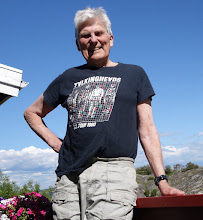I only show you this picture because at least here in Linköping my Somali friends whom I refer to as the Hijab Sisters do not want to be photographed. But that really is Shukri there.
Shukri was born in Mahaday 120 km north of Mogadishu. Somehow or other her parents found their way to Sweden which is where I am writing this. So part of Shukri's story is a story of going to school in a very cold country way up north.
She found me after I had written a comment in the Vermont Public Radio web pages describing a young Somali living in Burlington, Vermont, where I spend a month each year. This young Somali - last name Ahmed- had decided to show the world or at least Vermonters that a Somali could be a body builder. Somehow or other another Somali read that story and pretty soon I had three Somalis as Facebook Friends, two of them from Kismayo and living in America and the third, Shukri Islow going to University in Uganda.
Her Facebook is the place where she takes up the fight for women and girls in general and for Somali girls and young women in particular. After looking at her many entries today I have told her it is time for her to have her own blog.
Now a note about three Somali women who are well known to the world as maybe Shukri will someday be known. Edna Adan is a nurse who established a hospital in Hargeisa and Hawa Abdi is a doctor who did the same in Mogadishu. And now there is also Nadifa Mohamed, born in Hargeisa, educated at Oxfor, and author of a prize-winning novel The Orchard of Lost Souls.

I make contributions regularly to the two hospitals and have just sent a contribution to Edna Adan Hospital, which you can learn about at http://www.ednahospital.org/
Here is Edna Adan Ismail who has improved the lives of countless young Somali women as Shukri herself wants to do. I only wish it had been possible to show that my contribution tonight was in the name of Shukri Islow but there is no place for that at Edna's web page.
So Shukri, congratulations from all of the Hijab Sisters at the Red Cross here in Linköping, one of whom, Muhiim, wrote to you via my Facebook yesterday. They all think you are amazing.
Lycka till
Larry
























